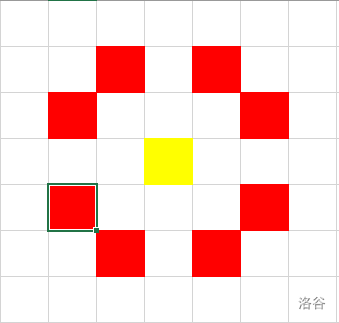题解 P4304 【[TJOI2013] 攻击装置】
纪念一下一遍过~
题目分析:
大意:在给定位置限制的前提和攻击范围的前提下,求能放置的最多装置数。
将攻击范围更直观的表示出来,如下图:

嗯。。。然而并没有神马用。
看题意将攻击坐标表示出来,肯定有用,尝试将横纵坐标的值加起来(为了方便,下文以和代替为横纵坐标之和):
所以我们发现,攻击坐标的和的奇偶性恰好与原坐标相反,也就意味着和的奇偶性相同的两个点必然不会相互攻击,所以我们就可以利用源汇点将两种点区分开来。
那么建图方式就很显然了:
- 如果和为奇数,从源点向该节点建有向边,边权为\(1\)(题意求的是数量);
- 反之,从该节点向汇点建有向边,边权为\(1\);
再考虑八个方向的攻击:
因为相互攻击的点不能同时选,所以在两个点之间建有向边,边权为 \(inf\)。
边权为极大值的原因:根据网络流的特性,最小割不能在边权为极大值的边上,所以为了保证割边一定与源点或汇点相连,赋为极大值。
最后,就是模板求最小割了。
完整代码:
#include<cstdio>
#include<algorithm>
#include<cstring>
using namespace std;
#define rt register int
#define int long long
const int N = 4e4 + 10, M = 1e6 + 10, inf = 1e10;
struct node {
int to,nex;
}e[M];
int n,s,t,top,ed,dep[N],head[N],cur[N],tot = 1,f[M],q[N],ans;
int a[8][2] = {{-1,-2},{-2,-1},{1,-2},{2,-1},{-1,2},{-2,1},{1,2},{2,1}};
char map[205][205];
inline void add(int x,int y,int w) {
e[++tot] = (node) {y,head[x]}, f[tot] = w, head[x] = tot;
e[++tot] = (node) {x,head[y]}, head[y] = tot;
}
inline bool bfs() {
memset(dep,-1,sizeof(dep));
dep[s] = 0, cur[s] = head[s], q[top = 1] = s; ed = 1;
int now,ver;
while(top <= ed) {
now = q[top++];
for(rt i = head[now]; i; i = e[i].nex) {
ver = e[i].to;
if(dep[ver] == -1 && f[i]) {
dep[ver] = dep[now] + 1, cur[ver] = head[ver];
if(ver == t) return 1;
q[++ed] = ver;
}
}
}
return 0;
}
inline int find(int x,int limit) {
if(x == t) return limit;
int flow = 0, tmp, ver;
for(rt i = head[x]; i && flow < limit; i = e[i].nex) {
ver = e[i].to;
if(dep[ver] == dep[x] + 1 && f[i]) {
tmp = find(ver,min(limit - flow,f[i]));
if(!tmp) dep[ver] = -1;
f[i] -= tmp, f[i ^ 1] += tmp, flow += tmp;
}
}
return flow;
}
inline int dinic() {
int flow;
while(bfs()) ans -= find(s,inf);
return ans;
}
inline void read(int &x) {
x = 0;
char s = getchar();
while(s < '0' || s > '9') s = getchar();
while(s <= '9' && s >= '0') {x = x * 10 + s - '0', s = getchar(); }
}
inline int pos(int x,int y) {
return n * (x - 1) + y;
}
signed main() {
read(n);
s = n * n + 1, t = s + 1;
int tx,ty;
for(rt i = 1; i <= n; i ++) {
scanf("%s",map[i] + 1);
for(rt j = 1; j <= n; j ++) {
if(map[i][j] == '1') continue;
ans ++;
if((i + j) & 1) {
add(s,pos(i,j),1);
for(rt k = 0; k < 8; k ++) {
tx = i +a[k][0], ty = j +a[k][1];
if(tx < 1 || ty < 1 || tx > n || ty > n || map[tx][ty] == '1') continue;//注意要判断该节点是否能放置装置
add(pos(i,j),pos(tx,ty),inf);
}
}
else add(pos(i,j),t,1);
}
}
printf("%d",dinic());
return 0;
}



 浙公网安备 33010602011771号
浙公网安备 33010602011771号